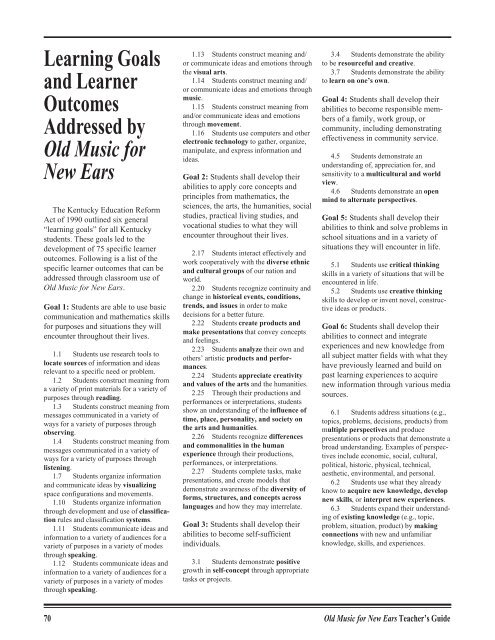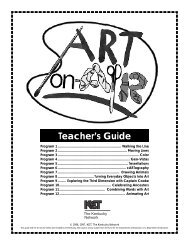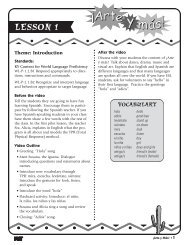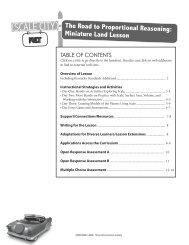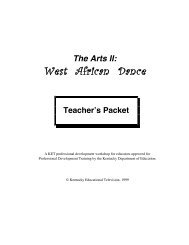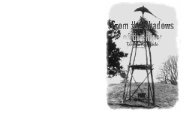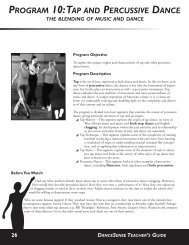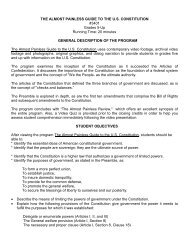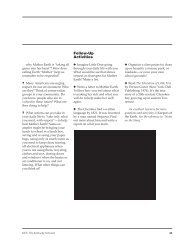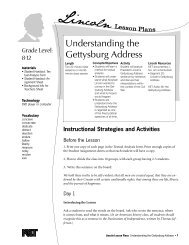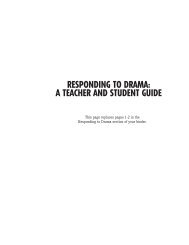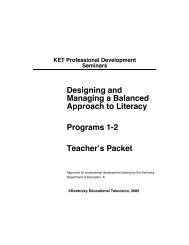7369 old music 2402 - KET
7369 old music 2402 - KET
7369 old music 2402 - KET
You also want an ePaper? Increase the reach of your titles
YUMPU automatically turns print PDFs into web optimized ePapers that Google loves.
Learning Goals<br />
and Learner<br />
Outcomes<br />
Addressed by<br />
Old Music for<br />
New Ears<br />
The Kentucky Education Reform<br />
Act of 1990 outlined six general<br />
“learning goals” for all Kentucky<br />
students. These goals led to the<br />
development of 75 specific learner<br />
outcomes. Following is a list of the<br />
specific learner outcomes that can be<br />
addressed through classroom use of<br />
Old Music for New Ears.<br />
Goal 1: Students are able to use basic<br />
communication and mathematics skills<br />
for purposes and situations they will<br />
encounter throughout their lives.<br />
1.1 Students use research tools to<br />
locate sources of information and ideas<br />
relevant to a specific need or problem.<br />
1.2 Students construct meaning from<br />
a variety of print materials for a variety of<br />
purposes through reading.<br />
1.3 Students construct meaning from<br />
messages communicated in a variety of<br />
ways for a variety of purposes through<br />
observing.<br />
1.4 Students construct meaning from<br />
messages communicated in a variety of<br />
ways for a variety of purposes through<br />
listening.<br />
1.7 Students organize information<br />
and communicate ideas by visualizing<br />
space configurations and movements.<br />
1.10 Students organize information<br />
through development and use of classification<br />
rules and classification systems.<br />
1.11 Students communicate ideas and<br />
information to a variety of audiences for a<br />
variety of purposes in a variety of modes<br />
through speaking.<br />
1.12 Students communicate ideas and<br />
information to a variety of audiences for a<br />
variety of purposes in a variety of modes<br />
through speaking.<br />
1.13 Students construct meaning and/<br />
or communicate ideas and emotions through<br />
the visual arts.<br />
1.14 Students construct meaning and/<br />
or communicate ideas and emotions through<br />
<strong>music</strong>.<br />
1.15 Students construct meaning from<br />
and/or communicate ideas and emotions<br />
through movement.<br />
1.16 Students use computers and other<br />
electronic technology to gather, organize,<br />
manipulate, and express information and<br />
ideas.<br />
Goal 2: Students shall develop their<br />
abilities to apply core concepts and<br />
principles from mathematics, the<br />
sciences, the arts, the humanities, social<br />
studies, practical living studies, and<br />
vocational studies to what they will<br />
encounter throughout their lives.<br />
2.17 Students interact effectively and<br />
work cooperatively with the diverse ethnic<br />
and cultural groups of our nation and<br />
world.<br />
2.20 Students recognize continuity and<br />
change in historical events, conditions,<br />
trends, and issues in order to make<br />
decisions for a better future.<br />
2.22 Students create products and<br />
make presentations that convey concepts<br />
and feelings.<br />
2.23 Students analyze their own and<br />
others’ artistic products and performances.<br />
2.24 Students appreciate creativity<br />
and values of the arts and the humanities.<br />
2.25 Through their productions and<br />
performances or interpretations, students<br />
show an understanding of the influence of<br />
time, place, personality, and society on<br />
the arts and humanities.<br />
2.26 Students recognize differences<br />
and commonalities in the human<br />
experience through their productions,<br />
performances, or interpretations.<br />
2.27 Students complete tasks, make<br />
presentations, and create models that<br />
demonstrate awareness of the diversity of<br />
forms, structures, and concepts across<br />
languages and how they may interrelate.<br />
Goal 3: Students shall develop their<br />
abilities to become self-sufficient<br />
individuals.<br />
3.1 Students demonstrate positive<br />
growth in self-concept through appropriate<br />
tasks or projects.<br />
3.4 Students demonstrate the ability<br />
to be resourceful and creative.<br />
3.7 Students demonstrate the ability<br />
to learn on one’s own.<br />
Goal 4: Students shall develop their<br />
abilities to become responsible members<br />
of a family, work group, or<br />
community, including demonstrating<br />
effectiveness in community service.<br />
4.5 Students demonstrate an<br />
understanding of, appreciation for, and<br />
sensitivity to a multicultural and world<br />
view.<br />
4.6 Students demonstrate an open<br />
mind to alternate perspectives.<br />
Goal 5: Students shall develop their<br />
abilities to think and solve problems in<br />
school situations and in a variety of<br />
situations they will encounter in life.<br />
5.1 Students use critical thinking<br />
skills in a variety of situations that will be<br />
encountered in life.<br />
5.2 Students use creative thinking<br />
skills to develop or invent novel, constructive<br />
ideas or products.<br />
Goal 6: Students shall develop their<br />
abilities to connect and integrate<br />
experiences and new knowledge from<br />
all subject matter fields with what they<br />
have previously learned and build on<br />
past learning experiences to acquire<br />
new information through various media<br />
sources.<br />
6.1 Students address situations (e.g.,<br />
topics, problems, decisions, products) from<br />
multiple perspectives and produce<br />
presentations or products that demonstrate a<br />
broad understanding. Examples of perspectives<br />
include economic, social, cultural,<br />
political, historic, physical, technical,<br />
aesthetic, environmental, and personal.<br />
6.2 Students use what they already<br />
know to acquire new knowledge, develop<br />
new skills, or interpret new experiences.<br />
6.3 Students expand their understanding<br />
of existing knowledge (e.g., topic,<br />
problem, situation, product) by making<br />
connections with new and unfamiliar<br />
knowledge, skills, and experiences.<br />
70 Old Music for New Ears Teacher’s Guide


